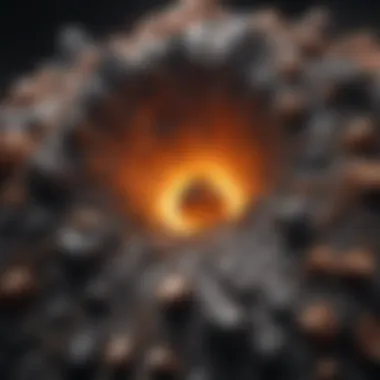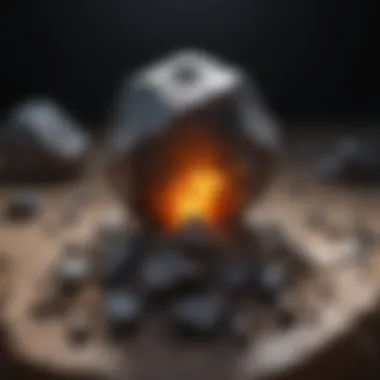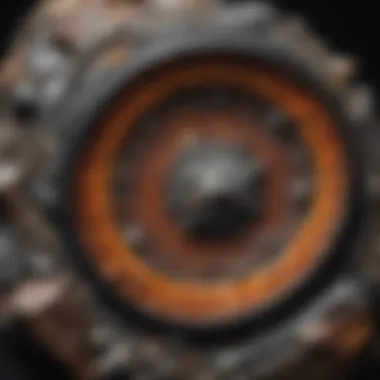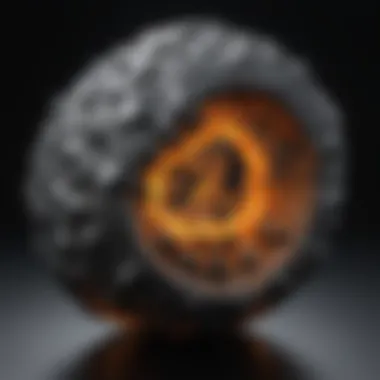Unlocking the Mysteries of Meteorites: A Guide for Rock and Fossil Enthusiasts


Rock and Fossil Identification
As a rock and fossil collector, it is imperative to master the skill of distinguishing meteorites from common rocks. Meteorites exhibit distinct characteristics that set them apart from terrestrial counterparts. These extraterrestrial specimens often possess a fusion crust, regmaglypts, and chondrules, which are key features to look for when identifying them. Utilizing the right tools, such as a magnet for detecting iron content or a portable microscope for intricate visual inspections, can immensely aid in the identification process.
Collecting Tips and Techniques
To excel in collecting meteorites, adopting best practices is essential. Ensure that you obtain necessary permissions before venturing into collecting areas, respecting both legal regulations and landowners' rights. Locating prime meteorite collecting sites involves research and exploration, focusing on regions with minimal vegetation cover for easier spotting of meteorites. When extracting specimens, caution is paramount to prevent damage; delicate tools like brushes and chisels can aid in safely removing meteorites from their embedment.
Preservation and Display
Preserving meteorites is crucial to maintain their integrity and value. Techniques such as cleaning with gentle brushes and storing in a low-humidity environment can prevent degradation over time. Proper storage methods include using acid-free containers and silica gel packs to control moisture levels. Displaying meteorites creatively enhances their aesthetic appeal; options include mounting specimens on stands, arranging them in curated collections, or incorporating them into jewelry for wearable art.
Geological Insights
Understanding the geological context of meteorites adds depth to their significance. These extraterrestrial rocks offer insights into celestial processes and the history of our solar system. Examining meteorites can unveil clues about planetary formation and evolution. Notable discoveries, such as rare meteorite falls or impact structures, contribute to expanding scientific knowledge and provide a window into Earth's dynamic past.
Prelude
The realm of meteorites beckons with a captivating mystique, drawing the curiosity of both novice and seasoned rock and fossil collectors. This article serves as a beacon, illuminating the intricate process of identifying these extraterrestrial gems amidst a sea of common stones. By unraveling the enigma shrouding meteorites, readers stand to gain a profound appreciation for these celestial visitors and their profound impact on geological studies.
Exploring the Mystique of Meteorites
The allure of meteorites
Embarking on a cosmic journey, the allure of meteorites lies in their otherworldly origin and exceptional rarity. Their magnetic pull transcends mundane rock collections, offering enthusiasts a glimpse into the vast expanse of the universe housed within palm-sized marvels. The iridescent fusion crust, unique to meteorites, serves as a hallmark of their celestial voyage, captivating collectors with its enigmatic charm. Within the realm of this article, the allure of meteorites unfolds as a key thread weaving together the fabric of ancient cosmic tales.
Significance in geological studies
Delving deeper, the significance of meteorites in geological studies transcends mere aesthetic allure, offering a window into the early days of our solar system. These extraterrestrial messengers carry invaluable insights into planetary formation and evolution, enriching scientific discourse with each chondrule and fusion crust. Within the context of this guide, their significance emerges as a beacon of knowledge, guiding collectors through the labyrinth of meteorite identification with a steady hand.
Purpose of the Guide
Educating collectors on meteorite identification
Within the intricate tapestry of meteorite identification, the guide assumes the role of a wise mentor, imparting invaluable wisdom to collectors embarking on this scientific quest. By shedding light on distinguishing characteristics and intricate patterns, this guide equips enthusiasts with the discerning eye needed to separate meteorites from terrestrial imposters. In the realm of this article, educating collectors on meteorite identification stands as a cornerstone, ensuring that each aspiring meteorite sleuth treads the path of knowledge with confidence.


Empowering readers with knowledge
Empowerment resonates as a central theme within this guide, as readers are not merely passive recipients of information but active participants in the scientific process. By imparting knowledge on meteorite identification, this guide nurtures a community of informed collectors poised to contribute meaningfully to scientific endeavors. The empowerment of readers emerges as a potent force driving the narrative of this article, instilling a sense of purpose and discovery in each individual seeking to unravel the mysteries of meteorites.
Key Characteristics of Meteorites
In the realm of rock and fossil collecting, understanding the key characteristics of meteorites holds paramount importance. Meteorites, as remnants of interstellar bodies that have landed on Earth, provide invaluable insights into the geology of our planet and the wider universe. By delving into their metallic composition, chondrules, and Widmanstätten patterns, collectors can unravel the mysteries of these extraterrestrial visitors, enhancing both their scientific knowledge and the allure of their collections.
Metallic Composition
Iron-nickel content:
The iron-nickel content serves as a defining feature of meteorites, setting them apart from terrestrial rocks. This composition, primarily comprising iron and nickel alloys, grants meteorites their characteristic density and magnetic properties. Collectors often value iron-nickel meteorites for their resilience to terrestrial weathering and the distinct crystalline structures that form upon cooling. Despite their susceptibility to rust and corrosion when exposed to atmospheric conditions, iron-nickel meteorites remain a popular choice among collectors due to their aesthetic appeal and scientific significance.
Presence of fusion crust:
The presence of fusion crust, a thin outer layer formed during the meteorite's fiery descent through Earth's atmosphere, serves as a crucial indicator of a meteoritic origin. This dark, glassy coating not only protects the inner meteorite from further weathering but also provides valuable clues about its atmospheric entry conditions. Collectors can assess the fusion crust's texture, thickness, and overall appearance to distinguish meteorites from terrestrial rocks. While the fusion crust may undergo alterations over time, its presence remains a key feature in meteorite identification, enriching the collector's understanding of each specimen's fascinating journey.
Chondrules and Widmanstätten Patterns
Defining features:
Chondrules, small, spherical inclusions found in some meteorites, offer a glimpse into the processes that shaped these cosmic objects during their formation. These distinctive features, formed by rapid cooling in the early solar system, exhibit a range of textures and compositions that vary between meteorite classifications. Collectors can study chondrules through microscopic examination, unraveling the unique stories encapsulated within each meteorite specimen.
Microscopic examination:
Microscopic examination plays a crucial role in identifying meteorites, enabling collectors to analyze intricate details invisible to the naked eye. By scrutinizing the crystalline structures, mineral compositions, and internal features of meteorites, collectors can categorize specimens based on their chondrules, Widmanstätten patterns, and other defining characteristics. This meticulous process provides insights into the meteorites' origins, histories, and potential classifications, enriching collectors' appreciation for these celestial remnants.
Visual Inspection Techniques
Visual Inspection Techniques play a crucial role in the comprehensive guide to Identifying Meteorites for Rock and Fossil Collectors. By visually examining meteorites, collectors can uncover essential characteristics that distinguish these space rocks from common terrestrial stones. The primary focus here lies in understanding fusion crust and magnetic properties, two key aspects instrumental in meteorite identification.
Checking for Fusion Crust
When it comes to Understanding fusion crust, collectors delve into the outermost layer of meteorites, a distinct feature resulting from heating during atmospheric entry. This crust holds vital clues to the meteorite's authenticity and extraterrestrial origin. Its unique texture and composition set meteorites apart from conventional rocks. However, a thorough grasp of fusion crust is imperative to prevent misidentifications, ensuring collectors avoid common pitfalls in their quest for meteorites.
Understanding fusion crust


The concept of Understanding fusion crust unravels the mystery behind meteorite surfaces. Its crunchy texture and darkened appearance are tell-tale signs of a fiery journey through Earth's atmosphere. While this feature adds to a meteorite's allure, misconceptions can arise without a keen eye for authentic fusion crust. Collectors must carefully assess this key characteristic to distinguish true meteorites from imitations accurately.
Lustre and texture
Within Lustre and texture lies another essential aspect of visual inspection. The gleam and feel of a meteorite's surface can indicate its composition and history. A glossy finish or unique patterns can hint at the meteorite's metallic nature or crystalline structure, shedding light on its formation process. Despite its significance, collectors must exercise cautious judgment, as certain terrestrial rocks may mimic meteorite properties, posing challenges in differentiation.
Magnetic Properties
Delving into the realm of Magnetic Properties opens another avenue for meteorite identification. By utilizing magnets, collectors can leverage the innate magnetism of iron-nickel meteorites to separate them from Earth-bound materials. Understanding how meteorites respond to magnetic fields enhances the detection process, offering a non-destructive means of confirming a specimen's extraterrestrial origin.
Use of magnets in identification
The Use of magnets in identification presents a practical approach to isolating meteorites based on their magnetic traits. Due to the high iron content found in many meteorites, they exhibit unique interactions with magnetic fields. Collectors benefit from this method by swiftly screening potential finds and streamlining the identification process. However, while magnets offer a convenient tool for enthusiasts, proper interpretation of magnetic responses remains essential to avoid misjudgments.
Response to magnetic fields
Analyzing Response to magnetic fields involves observing how meteorites attract or repel when subjected to magnetic influences. This distinct behavior aids collectors in differentiating meteorites from ordinary rocks, enabling them to sift through their collections with precision. While the magnetic test serves as a reliable indicator, collectors must approach it with discernment, considering variations in magnetic strengths and potential anomalies in certain meteorite specimens.
Advanced Testing Methods
In this elaborate guide catering to rock and fossil collectors, the section on Advanced Testing Methods holds paramount significance. Bringing forth a meticulous approach to identifying meteorites, this segment delves into sophisticated techniques essential for distinguishing these celestial visitors from regular terrestrial rocks. By delving into intricate methods of analysis, collectors can unravel the extraterrestrial origins of potential meteorites with precision and confidence.
X-ray Fluorescence
Analyzing elemental composition
Exploring the depths of meteorite examination, the analysis of elemental composition through X-ray Fluorescence emerges as a pivotal aspect in this informative article. This advanced method enables collectors to scrutinize the intricate chemical makeup of meteorites, providing invaluable insights into their unique characteristics. The non-invasive nature of this testing technique allows for comprehensive examination without altering the specimen's integrity, making it a preferred choice for discerning collectors seeking accurate identification.
Non-destructive testing
Within the realm of meteorite analysis, non-destructive testing plays a crucial role in revealing key details without causing harm to the sample. This approach allows collectors to gather essential data while preserving the meteorite's structure and composition. By utilizing non-destructive testing methods, enthusiasts can delve into the nuances of meteorite identification without compromising the specimen's integrity, ensuring a meticulous examination process.
Isotopic Analysis
Determining extraterrestrial origin
Unveiling the extraterrestrial origins of meteorites, isotopic analysis stands as a pivotal tool in this comprehensive guide. By scrutinizing isotopic compositions, collectors can trace the unique signatures that distinguish meteorites from earthly rocks, offering a definitive way to confirm their celestial nature. This method's precision and accuracy make it an invaluable resource for enthusiasts intent on unraveling the mysteries of meteorite identification.


Identifying unique isotopic ratios
Delving into the minute details of meteorite analysis, the identification of unique isotopic ratios provides a nuanced approach to distinguishing these cosmic relics. By examining the distinctive isotopic fingerprints embedded within meteorites, collectors can uncover vital clues about their formation and history. The ability to pinpoint these unique ratios offers collectors a profound insight into the composition and origin of meteorites, enriching their understanding of these captivating specimens.
Common Misconceptions
In the realm of meteorite identification, navigating common misconceptions is paramount to honing one's expertise. This section sheds light on the prevalent misunderstandings that can lead enthusiasts astray. By delving into the distinctions between authentic meteorites and look-alike rocks, readers will fortify their discernment and steer clear of misidentifications. Addressing these misconceptions not only refines one's collecting acumen but also contributes to the elevation of scientific accuracy in this niche field.
Meteorite vs. Meteorwrong
Understanding look-alike rocks
Set apart by their deceptive resemblance to true meteorites, look-alike rocks present a tantalizing challenge to collectors. Understanding the subtle nuances that differentiate these imposters from genuine meteorites is quintessential in avoiding misjudgments. The allure of look-alike rocks lies in their intricate mimicry, often fooling even seasoned collectors. By deciphering the telltale signs of pseudo meteorites, readers can enhance their identification prowess and bypass missteps, thereby enriching their collection with veritable celestial specimens.
Avoiding false identifications
Mitigating the risks of mislabeling specimens hinges on meticulously steering clear of false identifications. Thorough examination and scrutiny are vital in discerning the unique features that set true meteorites apart from counterfeit counterparts. A vigilant approach to identifying key markers of authenticity shields collectors from falling prey to misrepresentations. Learning to distinguish the nuanced differences between real meteorites and imposters bolsters the credibility of collections and safeguards against inadvertent misclassifications.
Commercial Considerations
When delving into the realm of meteorite acquisition, navigating the intricacies of commercial transactions is crucial for collectors. This section navigates the terrain of evaluating authenticity amidst a market brimming with potential pitfalls and counterfeit schemes. Equipping readers with the tools to discern genuine meteorites from fraudulent imitations bolsters their confidence in making informed purchases, safeguarding their interests from unscrupulous actors.
Evaluating authenticity
The process of evaluating the authenticity of meteorites presents collectors with a litmus test for genuineness. Scrutinizing key characteristics such as fusion crust, chondrules, and Widmanstätten patterns empowers collectors to make astute judgments regarding a specimen's legitimacy. By honing their ability to authenticate meteorites, readers elevate their collection's worth and authenticity, ensuring each acquisition aligns with their discerning standards.
Avoiding scams
Navigating the meteorite market necessitates a keen awareness of potential scams lurking in the shadows. Fostering a proactive stance against deceitful practices safeguards collectors from falling victim to fraudulent schemes. By highlighting red flags and precautionary measures, readers can fortify their defenses against unscrupulous vendors, preserving the integrity of their collections and investments.
Ending
As we draw the curtains on this exhaustive guide to meteorite identification, it becomes evident that delving into the world of meteorites is not merely about collecting rare rocks but about unlocking the mysteries of our universe housed within them. This conclusion serves as a gateway for enthusiasts to embark on a journey of eternal learning and contribution to the realm of scientific knowledge. By embracing the art of meteorite sleuthing, one can transcend mere identification and play a pivotal role in expanding our understanding of celestial objects forged beyond our planet.
Becoming a Meteorite Sleuth
Continuous learning and observation
Venturing into the realm of meteorite sleuthing necessitates a relentless pursuit of continuous learning and keen observation. This pivotal aspect underscores the essence of honing one's skills through perpetual education and unwavering vigilance in identifying minute variations that set meteorites apart from earthly rocks. The crux of continuous learning and observation lies in its capacity to sharpen one's discerning eye, enabling collectors to sift through cosmic debris with unparalleled accuracy and expertise. While the journey of constant growth may pose challenges, the rewards of mastering this discipline are boundless, offering enthusiasts a gateway to unravel the enigmatic origins of meteorites.
Contributing to scientific knowledge
Embracing the role of contributing to scientific knowledge elevates meteorite sleuths to the status of pioneers in astronomical exploration. By sharing findings, collaborating with experts, and actively participating in research endeavors, collectors can pave the way for groundbreaking discoveries in the field of meteoritics. The significance of this noble endeavor lies in its capacity to enrich our understanding of meteorites' composition, formation, and journey through space, thereby adding valuable pieces to the cosmic puzzle. While the responsibility of scientific contribution may seem daunting, the thrill of uncovering hitherto unknown facets of meteorites outweighs any obstacles, propelling enthusiasts towards a fulfilling and intellectually rewarding pursuit.







